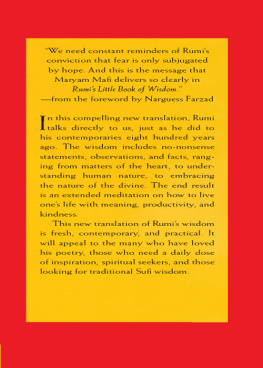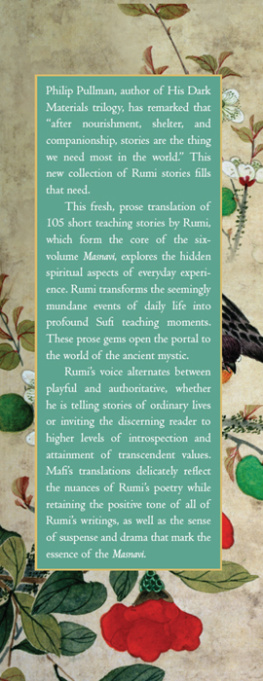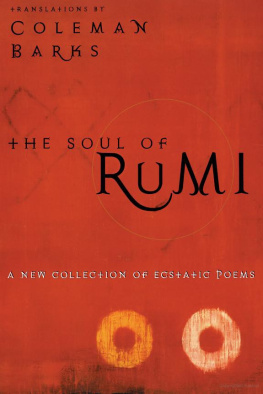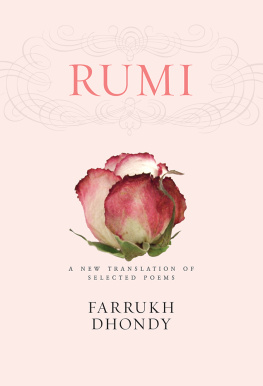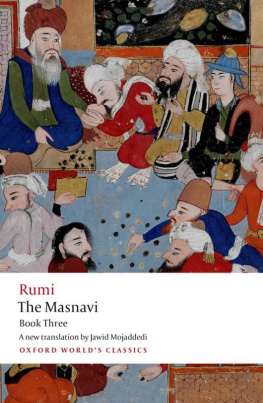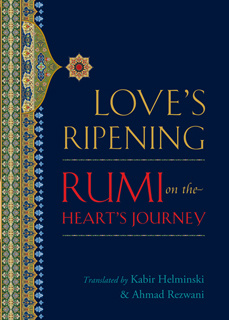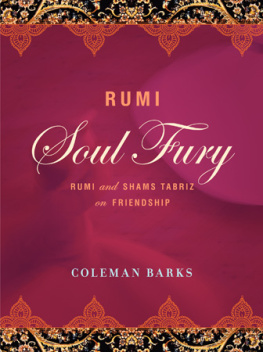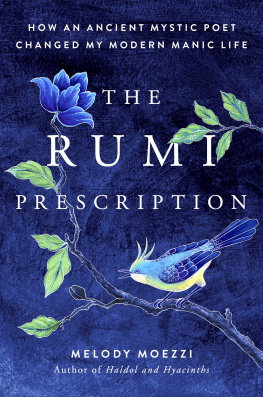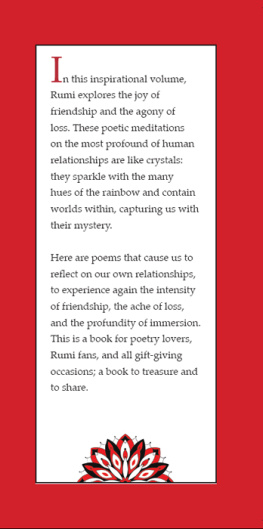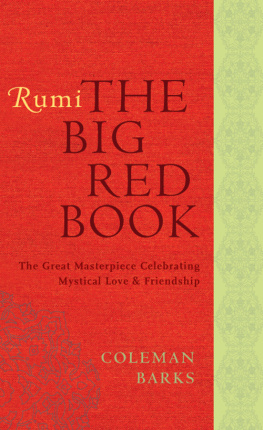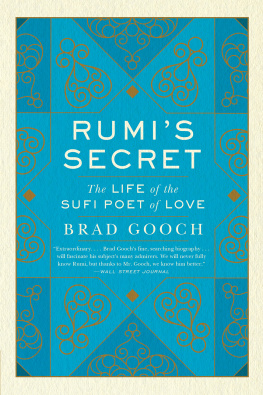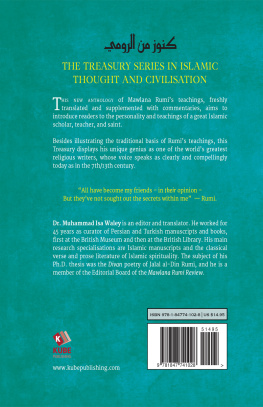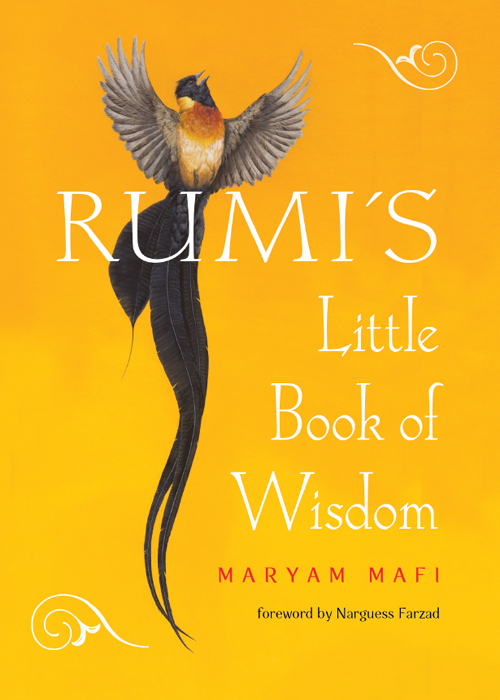
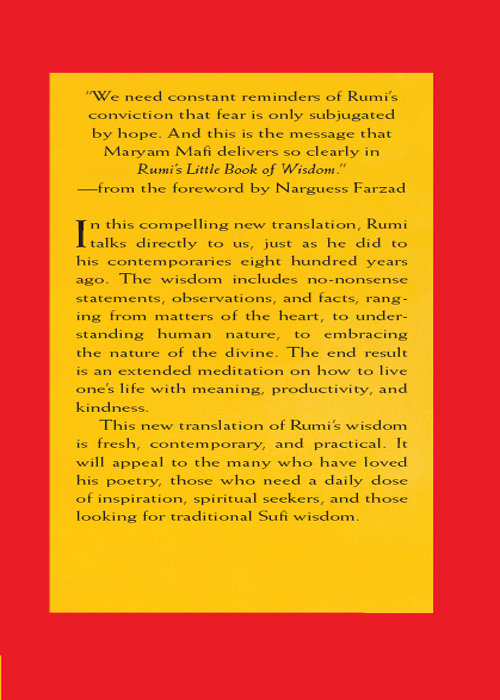

Copyright 2021
by Maryam Mafi
Foreword 2021 Narguess Farzad
All rights reserved. No part of this publication may be reproduced or transmitted
in any form or by any means, electronic or mechanical, including photocopying,
recording, or by any information storage and retrieval system, without
permission in writing from Red Wheel/Weiser, LLC.
Reviewers may quote brief passages.
Cover artwork: Private Collection
Tim Hayward / Bridgeman Images
Cover and interior design by Kathryn Sky-Peck
Typeset in Weiss
Hampton Roads Publishing Company, Inc.
Charlottesville, VA 22906
Distributed by Red Wheel/Weiser, LLC
www.redwheelweiser.com
Sign up for our newsletter and special offers by going to
www.redwheelweiser.com/newsletter.
ISBN: 978-1-64297-025-8
Library of Congress Cataloging-in-Publication Data available upon request.
Printed in the United States of America
M&G
10 9 8 7 6 5 4 3 2 1
For Niloufar Bayani


CONTENTS

FOREWORD
A n online search for the name Rumi quickly returns tens of millions of results, offering links to a multitude of sites presented in a variety of languages. These sites are devoted to, or focus on, a 13th-century Persian poet whose social-media presence and ever-increasing number of groupies would be the envy of many a celebrity or public figure. The sheer quantity of just the English-language search results stands as a testament to the attraction that Rumi's philosophy and ecstatic poetry have for his followers and devotees, as well as for those who, in times of strife, seek solace and rectitude in his words and beliefs. When ordinary lives are wrenched apart by unanticipated crises, pandemics, acts of violence, and other disasters brought about by humankind's actions, more and more people are turning to this Islamic jurist, teacher, scholar, and mystic for guidance and inspiration.
Quotable fragments are routinely drawn from Rumi's longer narrative poems to become memorable nuggets that are shared and tweeted and uploaded on popular social-media platforms. Even Beyonc and Jay-Z, arguably the most powerful couple in the world of entertainment, named one of their daughters Rumifor no more beguiling reason than that he is their favorite poet. So who is this extraordinary figure who, more than 800 years after his birth in Central Asia, continues to be revered? And which country or culture can rightfully claim him as its own?
Born Jalal ad-Din Balkhi, he is known in the West as Rumi, which means the man from Rum, a region that lay on the eastern edges of the Byzantine Empire. His devotees, to whom he is known as Mowlana (Our Master), place his birth in the year 1207 in the northeastern corner of the Perso-Islamic Empire in the province of Vakhsh in modern-day Tajikistan, which is located by one of the tributaries of the magnificent Amu Darya, the River Oxus. The historical cities of his childhood, Samarqand and Balkh, are now located in present-day Uzbekistan and Afghanistan respectively. Yet Rumi's discourses, poetry, and lyrical songs were written in Persian, and he spent most of his adult life in Konya, in modern-day Turkey, where he is buried.
All this leads to the assertion that no country or culture can exclusively claim Rumi's legacy and heritage as its own. He is truly a universal poet and thinker. Furthermore, the innumerable translations of his works into more than thirty languages, with more in the pipeline, have made it possible for people from widely diverse cultures to enjoy the profundity of his writings and the richness of his imagination. Indeed, readers from across the globe have forged an affinity with Rumi's evocative reflections on life and faith. Rumi's poetry remains the touchstone for mystical compositions in the Islamic world, and his teachings remain as relevant and captivating today as they were in medieval times.
Academic discussions of Rumi's writings and the genesis of his Sufiistic philosophy fill innumerable bookshelves in research libraries around the world. They are pored over and debated at conferences and are the frequent topic of university lectures and courses. But it is thanks to devoted and scholarly translators like Maryam Mafi, who lovingly selects the best and the most life-affirming examples of his work, that Rumi has now become accessible to a wider discerning public. In The Little Book of Mystical Secrets, Mafi focused on the teachings and inspirations of Shams of Tabriz, Rumi's teacher, confidant, and soulmate. In The Book of Rumi: 105 Stories and Fables, she selected from the six-volume magnum opus the Masnavi, the Spiritual Couplets. In Rumi's Little Book of Wisdom, Mafi has finally turned her attention to a much lesser-known work, the Fihe-ma-Fih, a compendium of Rumi's monologues, discussions, and reflections on a life of writing and worship, as recorded by his followers.
There is much debate about the meaning and origins of the title of this work. Although the book is written in Persian, the titlein keeping with the traditions of the timeis an Arabic spiritual expression that means in it what is in it. Finding an exact English equivalent for this ambiguous title has been a challenge for many translators over time. While some have opted for It Is What It Is, others have simply chosen a generic title like Discourses of Rumi that describes the content of the book. Harvard professor Annemarie Schimmel (19222003), the indomitable German Orientalist and scholar of Islam and Sufism, preferred to interpret the title in its original sense, as a kind of spiritual potlucka meal of simple fare assembled for unexpected or uninvited guests that can be shared in any circumstance or at any time.
Primary authorship of the Fihe-ma-Fih is attributed to Rumi's eldest son, Sultan Walad, who was assisted by other unnamed pupils and disciples of the Master. These devoted followers are believed to have recorded the reminiscences of their Master faithfully and accurately, and to have noted all his answers to questions posed at gatherings, as they would the revelations of a saintly figure. What remains today of what must originally have been a much larger volume consists of an introduction and seventy chapters of anecdotes, exchanges, and amplifications of ideas that date from approximately 1260 until after Rumi's death in 1273.
Professor Badiozzaman Forouzanfar (19041970), one of the most prominent Iranian Rumi scholars and editor of the Fihe-ma-Fih, believed that the title was, in all likelihood, inspired by a line in Book 5 of the Masnavi (lines 26832685), where Rumi tells the story of a sage named Shiekh Mohammad Sar-Razi of Ghazni, a city in modern Afghanistan. According to the tale, this Sufi sheikh had fasted for seven years, only breaking his fast once every evening by chewing on some vine leaves. This lengthy period of meditation and abstinence sharpened his senses and powers of perception to such an extent that he claimed he could fathom the might and glory of the Divine as reflected in the minutiae of the natural world. Despite his sense of proximity to the Divine, however, he longed desperately for more, aspiring to see the visage of his Lord.
Next page
